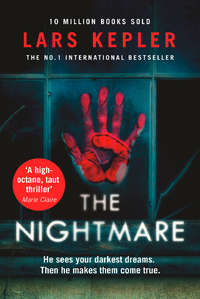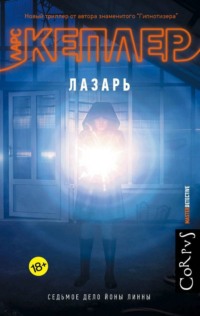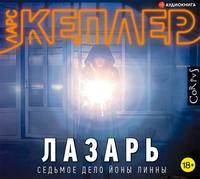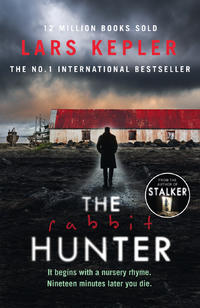
Полная версия
Stalker
‘OK, listen,’ Erik says. ‘I know this is completely wrong, but in one of the last conversations I had with Rocky, he claimed he had an alibi for the night of the murder, but I didn’t want him to be released simply because he’d bought himself a witness.’
‘What are you trying to say?’ she asks quietly.
‘I never passed that information on.’
‘No way,’ she says.
‘He could have been released—’
‘Bloody hell, you can’t do that!’ she interrupts.
‘I know, but he was guilty and he would have killed again.’
‘That’s not our business, we’re psychologists, we’re not detectives, and we aren’t judges …’
She takes a few agitated steps, then stops and shakes her head.
‘Fucking hell,’ she gasps. ‘You’re mad, you’re completely—’
‘I can understand you being angry.’
‘Yes, I am angry. I mean, you know, if this gets out you’d lose your job.’
‘I know what I did was wrong, it’s tormented me ever since, but I’ve always been utterly convinced that I stopped a murderer.’
‘Shit,’ she mutters.
He picks up the business card from his desk and begins to dial the superintendent’s number.
‘What are you doing?’ she asks.
‘I need to tell her about Rocky’s alibi, and the whole business about the hand and the ear, and—’
‘Go ahead,’ she interrupts. ‘But what if you were right, what if his alibi wasn’t real? Then any similarities are just coincidence.’
‘I don’t care.’
‘Then ask yourself what you’re going to do with the rest of your life,’ she says. ‘You’ll have to give up being a doctor, you’ll lose your income, you might even face charges, all the scandal and gossip in the papers—’
‘It’s my own fault.’
‘Find out if the alibi checks out first – if it does, then I’ll report you myself.’
‘Thanks,’ he laughs.
‘I’m being serious,’ she says.
18
Erik leaves the car in front of the garage, hurries up the path to his dark house, unlocks the door and goes inside. He turns the light on in the hall but doesn’t take his outdoor clothes off, just carries on down the steep staircase to the cellar that contains his extensive archive.
In the locked steel cabinets he keeps all the documents from his years in Uganda, from the major research project at the Karolinska Institute, and about his patients at the Psychology Clinic. All the written material is collected in the form of logbooks, personal journals and extensive notes. The recordings of his sessions have been saved on eight external hard-drives.
Erik’s heart is thumping as he unlocks one of the cabinets and searches back in time to the year when his life crossed paths with that of Rocky Kyrklund.
He pulls the file out of a black box and hurries upstairs to his study. He switches the lamp on, glances at the black window, removes the elastic band round the file, and opens it on the desk in front of him.
It was nine years ago, and life was very different. Benjamin was still in primary school, Simone was writing her dissertation in art history, and he himself had just started working at the Crisis and Trauma Centre with Professor Sten W Jakobsson.
He no longer remembers the exact details of how he was contacted and invited to join a team for a forensic psychology project. He had actually decided not to take part in anything like that again but, given the particular circumstances, changed his mind when his colleague Nina Blom asked for his help.
Erik remembers spending the evening in his new office, reading the material the prosecutor had sent over. The man who was going to be evaluated was a Rocky Kyrklund, and he was vicar of the parish of Salem. He was being held in custody on suspicion of having murdered Rebecka Hansson, a forty-three-year-old woman who had attended Mass and then stayed behind to speak to him in private on the Sunday before she was murdered.
The murder had been extremely aggressive, fuelled by hatred. The victim’s face and arms had been destroyed. She was found lying on the linoleum floor of her bathroom, with her right hand around her neck.
There was fairly persuasive forensic evidence. Rocky had sent her a number of threatening text messages, and his fingerprints and strands of his hair were found in her home, and traces of Rebecka’s blood were found on his shoes.
An arrest warrant was issued and he was eventually picked up seven months later in conjunction with a serious traffic accident on the motorway at Brunnby. He had stolen a car at Finsta and was heading for the airport at Arlanda.
In the accident Rocky Kyrklund suffered serious brain damage which led to epileptic seizures in the frontal and temporal lobes of his brain.
He would suffer recurrent bouts of automatism and memory loss for the rest of his life.
When Erik met Rocky Kyrklund, his face was criss-crossed with red scars from the accident, his arm was in plaster, and his hair had just started to grow again after several operations. Rocky was a large man with a booming voice. He was almost two metres tall, broad-shouldered, with big hands and a thick neck.
Sometimes he would faint, falling off his chair, knocking over the flimsy table holding glasses and a jug of water, and hit his shoulder on the floor. But sometimes his epileptic attacks were almost invisible. He just seemed a bit subdued and distant, and afterwards he couldn’t remember what they had been talking about.
Erik and Rocky got on fairly well. The priest was undeniably charismatic. He somehow managed to give the impression of speaking straight from the heart.
Erik leafs through the private journal in which he made notes during their conversations. The various subjects can be traced from one session to the next.
Rocky had neither admitted nor denied the murder; he said he couldn’t remember Rebecka Hansson at all, and couldn’t explain why his fingerprints had been found in her home, or how her blood came to be on his shoes.
During the best of their conversations, Rocky would circle the small islands of memories in an attempt to discern a bit more.
Once he said that he and Rebecka Hansson had had intercourse in the sacristy, albeit interrupted. He could remember details, such as the rough rug they had been lying on. An old gift from the young women of the parish. She had begun to menstruate, leaving a small bloodstain, like a virgin, he said.
During the following conversations he couldn’t remember any of this.
The conclusion of the examination was that the crime had been committed under the influence of severe mental disturbance. The team believed that Rocky Kyrklund suffered from a grandiose, narcissistic personality disorder with elements of paranoia.
Erik leafs past a circled note, ‘paying for sex + drug abuse’, in the journal, followed by some ideas for medication.
Naturally he shouldn’t have had an opinion on the matter of guilt, but as time passed Erik became convinced that Rocky was guilty, and that his mental disorder constituted a serious risk of further crimes.
During one of their last sessions, Rocky was talking about a ceremony to mark the end of the school year in a church decked out with spring greenery, when he suddenly looked up at Erik and said he hadn’t murdered Rebecka Hansson.
‘I remember everything now, I’ve got an alibi for the whole of that evening,’ he said.
He wrote down the name Olivia, and an address, then gave the sheet of paper to Erik. They carried on talking, and Rocky began to speak in broken fragments, then fell completely silent, looked at Erik, and suffered a severe epileptic attack. Afterwards Rocky didn’t remember anything, he didn’t even recognise Erik, just kept whispering about wanting heroin, saying he could kill a child if only he was given thirty grams of medical diacetylmorphine in a bottle with an unbroken seal.
Erik never took Rocky’s claim of an alibi seriously. At best it was a lie; at worst Rocky could have bribed or threatened someone to support the alibi.
Erik threw away the scrap of paper, and Rocky Kyrklund was found guilty and sentenced to secure psychiatric care, with severe restrictions on any parole application.
And nine years later a woman is murdered in Bromma in a way that was reminiscent of Rebecka Hansson’s murder, Erik thinks, closing the file bearing Rocky’s name.
Aggressive violence directed at the face, neck and chest.
But, on the other hand, murders of this sort aren’t altogether unusual. They can be triggered by anything from the jealousy of an ex-husband, aggression linked to Rohypnol and anabolic steroids, so-called honour killings, or a pimp making an example of a prostitute trying to break away from him.
The only concrete connection is that Susanna Kern was left at the scene of the murder with her hand covering her ear, just like Rebecka Hansson was found on the floor with her hand round her own neck.
Perhaps Susanna Kern merely got tangled up in the belt of her kimono during the struggle.
The parallels certainly aren’t unambiguous, but they are there, and they’re forcing Erik to do something he should have done a long time ago.
He puts the file in his desk drawer and looks up the number of senior consultant Simon Casillas at Karsudden Hospital once more.
‘Casillas,’ the man answers in a voice like dried leather.
‘Erik Maria Bark from the Karolinska.’
‘Hello again.’
‘I’ve checked my diary, and I could actually squeeze in a visit.’
‘A visit?’
The sound of a squash court is audible in the background, a ball hitting the wall, the squeak of shoes.
‘I’m taking part in a research project for the Osher Centre at the Institute which involves us following up on old patients, right across the spectrum … which means I’m going to have to interview Rocky Kyrklund.’
Before they end the conversation Erik hears himself babble about the fabricated research project, about health-service funding, tax declarations, online CBT, and someone called Doctor Stünkel.
He slowly puts his phone down on the desk. Watches the little screen turn black as it slips into dormancy. The room is perfectly still. His leather seat creaks quietly like a moored boat. Through the open window he can hear the hiss of an evening shower approach across the gardens.
He bends forward and rests his elbows on the desk, leans his head on his hands and asks himself what on earth he’s doing. What did I just say? he thinks. And who the hell is Stünkel?
This could be a crazy idea, he knows that. But he also knows he has no choice. If Rocky’s alibi was genuine, then he must be released, even if that would mean a media frenzy and a miscarriage of justice.
Erik skims through the logbook. There are no notes about an alibi, but towards the end one page has been torn out. He leafs forward, then stops. From that last session with Rocky there’s a faint note in pencil that Erik doesn’t remember. In the middle of the page, it says ‘a priest with dirty clothes’ across the lines, then the remainder of the book is blank.
He stands up and goes out into the kitchen to find something to eat. While he walks through the library he repeats to himself that he has to find out if Rocky’s alibi was real.
If it was genuine, then this new murder could be connected to the old one, and Erik will have to confess everything.
19
Saga Bauer is driving slowly through the vast campus of the Karolinska Institute. As she approaches Retzius väg 5, she turns into the deserted car park and stops in front of the empty building.
Even though she’s tired and not wearing any make-up, hasn’t washed her hair and is wearing baggy clothes, most people would probably say she was the most beautiful person they had ever seen.
Recently there’s been something hungry and hunted about her appearance: the bright blue of her eyes makes her creamy white skin look radiant.
On the floor in front of the passenger seat is a green holdall containing underwear, a bulletproof vest and five cartridges of ammunition: .45 ACP, hollow-tipped.
Saga Bauer has been on sick leave from her job with the Security Police for more than a year, and she hasn’t visited the boxing club in all that time.
The only time she’s missed work was during Barack Obama’s visit to Stockholm. She stood at a distance and watched the President’s cortège. Being constantly on the lookout for threats is an occupational hazard. She remembers the tingle that ran through her body when she identified a potential vantage point from which to fire a rocket-propelled grenade, an unguarded window, but a moment later the danger had passed and nothing had happened.
The Forensic Medicine Department is closed, all the lights in the red-brick building seem to be off, but a white Jaguar with a damaged front bumper is parked on the path right in front of the entrance.
Saga leans to the side, opens the glove compartment, takes out the glass jar and leaves the car. The air is mild and smells of freshly mown grass. She feels her Glock 21 bouncing under her left arm, and can hear a faint sloshing sound from the jar as she walks.
Saga has to clamber across the flowerbed to get past Nils Åhlén’s car. The thorns of the wild rose make a scratching sound as they let go of her military trousers. The branches sway and a few rose petals drift to the ground.
The lock of the front door is prevented from clicking shut with the help of a rolled-up information leaflet.
She’s been here enough times before to find her way. The grit on the poorly cleaned floor crunches as she heads down the corridor towards the swing-door.
She can’t help smiling when she looks at the jar, and the cloudy liquid, the particles circling round.
The memory flashes through her, and her free hand goes involuntarily to one of the scars he left on her face, the deep cut just below her eyebrow.
Sometimes she thinks he must have seen something special in her, that that was why he spared her life, and sometimes she thinks that he simply considered death too easy – he wanted her to live with the lies he had made her believe, in the hell he had created for her.
She’ll never know.
The only thing that is certain is that he chose not to kill her, and she chose to kill him.
She thinks of the darkness and the deep snow as she walks down the empty corridor of the Forensic Medicine Department.
‘I hit him,’ she whispers to herself.
She moistens her mouth, and in her mind’s eye sees herself firing and hitting him in the neck, arm and chest.
‘Three shots to the chest …’
She changed her magazine and shot him again when he’d fallen into the rapids, she held the flare up and saw the cloud of blood spread out around him. She ran along the bank, shooting at the dark object, and carried on firing even though the body had been carried off by the current.
I know I killed him, she thinks.
But they never found his body. The police sent divers under the ice, and checked both banks with sniffer-dogs.
Outside the office is a neat metal sign bearing his name and title: Nils Åhlén, Professor of Forensic Medicine.
The door is open, and the slight figure is sitting at his neat desk reading the newspaper with a pair of latex gloves on his hands. He’s wearing a white polo-neck shirt under his white coat, and his pilot’s sunglasses flash as he looks up.
‘You’re tired, Saga,’ he says amiably.
‘A bit.’
‘Beautiful, though.’
‘No.’
He puts the newspaper down, pulls off the gloves and notices the quizzical look in her eyes.
‘To save getting ink on my fingers,’ he says, as though it were obvious.
Saga doesn’t answer, just sets the jar down in front of him. The chopped-off finger moves slowly in the alcohol, through a cloud of wispy particles. A swollen and half-rotten index finger.
‘So you think that this finger belonged to …’
‘Jurek Walter,’ Saga says curtly.
‘How did you get hold of it?’ Nils Åhlén asks.
He picks up the jar and holds it up to the light. The finger falls against the inside of the glass as if it were pointing at him.
‘I’ve spent more than a year looking …’
To start with Saga Bauer borrowed sniffer-dogs and walked up and down both banks of the river, from Bergasjön all the way to Hysingsvik on the Baltic coast. She followed the shoreline, combed the beaches, studied the currents of Norrfjärden all the way down to Västerfladen, and made her way out to every island, talking to anyone who went fishing in the area.
‘Go on,’ Åhlén said.
She looks up and meets his relaxed gaze behind the shimmering surface of his sunglasses. His latex gloves are lying on the desk in front of him, inside out, in two little heaps. One is quivering slightly, either from a draught or because of the rubber contracting.
‘This morning I was walking along the beach out at Högmarsö,’ she explains. ‘I’ve been there before, but I gave it another go … the terrain on the north side is quite tricky, a lot of forest on the cliffs at the headland.’
She thinks of the old man walking towards her from the other direction with an armful of silver-grey driftwood.
‘You’ve gone quiet again.’
‘Sorry … I bumped into a retired church warden … he said he’d seen me the last time I was there, and asked what I was looking for.’
Saga went with him to the inhabited part of the island. Less than forty people live there. The warden’s house is tucked behind the white chapel and freestanding bell tower.
‘He said he found a dead body on the shore towards the end of April …’
‘A whole body?’ Åhlén asks in a low voice.
‘No, just the torso and one arm.’
‘No head?’
‘No one can live without a torso,’ she says, and can hear how agitated her voice sounds.
‘No,’ Åhlén replies calmly.
‘The warden said the body must have been in the water all winter, because it was badly swollen, and very heavy.’
‘They look terrible,’ Åhlén said.
‘He brought the body back through the forest in his wheelbarrow, and laid it on the floor of the tool-shed behind the chapel … but the smell drove his dog mad, so he had to take it to the old crematorium.’
‘He cremated it?’
She nods. The crematorium had been abandoned for decades, but in the middle of the overgrown foundations was a sooty brick oven with a chimney. The warden used to burn rubbish in the oven, so he knew it worked.
‘Why didn’t he call the police?’ Åhlén asked.
Saga thinks of the way the churchwarden’s house stank of fried food and old clothes. His neck was streaked with dirt and the bottles of home-brew in the fridge had dirty marks from his fingers.
‘He had a still at home … I don’t know. But he did take a few pictures with his mobile in case the police showed up and started asking questions … and he kept the finger at the bottom of his fridge.’
‘Have you got the pictures?’
‘Yes,’ she says, and pulls out her phone. ‘It must be him … look at the gunshot wounds.’
Åhlén looks at the first picture. On the bare cement floor of the tool-shed lies a bloated, marbled torso with just one arm. The skin has split across the chest and slipped down. There are four ragged gunshot holes on the body. The water has made a black mark on the pale grey floor – a shadow that gets narrower towards the drain in the floor.
‘That looks good, very good,’ Nils Åhlén said, handing her phone back.
There is a tense look in his eyes as he gets to his feet and picks the glass jar up from the desk, and he looks at her as if he were about to say something else, but walks out of the room instead.
20
Saga follows Nils Åhlén through a dark corridor with narrow wheel-tracks on the floor, into the closest pathology lab. The chilly fluorescent lights in the ceiling flicker a few times before settling and lighting up the white tiled walls. Beside one of the metal tables is a desk with a computer and a large bottle of Trocadero.
The room smells of disinfectant and drains. A bright yellow hose is attached to one of the taps. A trickle of water runs from the end of the hose towards the drain in the floor.
Åhlén walks straight over to the long, plastic-covered post-mortem table with its double trough and drainage runnels.
He pulls over a chair for Saga, then places the glass jar on the slab.
She watches him put on protective overalls, a mask and latex gloves. Then he stops, quite still, in front of the jar, like an old person disappearing into a memory. Saga is on the point of saying something when Åhlén takes a deep breath.
‘The right finger of a body found in brackish water, preserved in strong alcohol at a temperature of eight degrees for four months,’ he says to himself.
He photographs the jar from various angles, then unscrews the lid bearing the words BOB Raspberry Jam.
Using a pair of steel tweezers he removes the finger, lets it drip for a while, then puts it down on the post-mortem table. The nail has come off, and is still lying in the murky liquid. A nauseating smell of rotten seawater and decaying flesh spreads through the room.
‘It’s certainly true that the finger was removed from the body long after death,’ he says to Saga. ‘With a knife or perhaps a pair of pliers or secateurs …’
Åhlén is breathing audibly through his nose as he carefully rolls the finger over so he can photograph it from every angle.
‘We can get a good fingerprint from this,’ he says seriously.
Saga has backed away, and is standing with her hand over her mouth, watching as Åhlén picks up the dead finger and holds it against a print-scanner.
The machine bleeps when the print has been scanned.
The tissue is swollen and pudgy, but the fingerprint that appears in the little screen is still very clear.
The papillary lines are really the ridges between the cells and sweat pores that develop in the epidermis while an embryo is still in the womb.
Saga stares at the oval containing a labyrinth of swirls.
The room feels full of suppressed anticipation.
Åhlén takes off his protective clothing again and logs into the computer, hooks up the scanner and clicks on the icon with the text LiveScan.
‘I’ve got a private AFIS system,’ he says straight out as he clicks another icon and types in a new password.
Saga sees him search for ‘Walter’, then click to bring up the digital image of the ID form that was compiled at the time of Jurek’s arrest. The sharp reproductions of the thumb and fingerprints from both hands were made in ink.
Saga tries to control her breathing.
Sweat is trickling down her sides from her armpits.
Åhlén whispers something to himself, and drags the best image from LiveScan across to the search box of the AFIS system, then clicks the button saying Analysis and Comparison, and immediately gets a result.
‘What’s happening?’ Saga says, and swallows hard.
The reflections of the fluorescent lights slide across his glasses. She sees his hand shake as he points at the screen.
‘The details of the initial level are rather vague … mostly just patterns,’ Åhlén explains, and clears his throat quickly. ‘The second level are so-called Galton details … you can see the length of the papillary lines and the way they relate to each other. The differences are only the result of tissue breakdown … And the third level, that’s primarily concerned with the layout of pores, and there the match is perfect.’
‘Do you mean that we’ve found Jurek?’ she whispers.
‘I’ll send the DNA to the National Forensics Lab in Linköping, but purely as a formality,’ he replies with a nervous smile. ‘You’ve found him, there’s no doubt that it’s him. It’s over now.’
‘Good,’ she says, feeling hot tears well up in her eyes.
The initial relief is full of contradictory impulses and emptiness. Her heart is still pounding hard in her chest.









